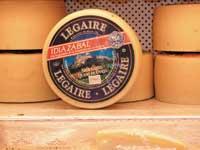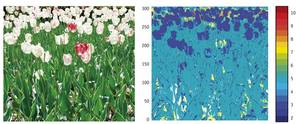Food, milk and cheese
2011/07/01 Abilleira, Eunate - Elikagaien Zientzian eta Teknologian doktorea Iturria: Elhuyar aldizkaria
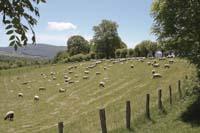
Since man began to devote himself to livestock, animal production systems have developed dramatically, which has meant a continuous improvement in the production and quality of animal foods. Currently, in the same region we can find many types of livestock, some of which are based on the management of local breeds and resources. In the Basque Country, the production of latxa sheep is known since the Palaeolithic, and it can be said that it has become a sign of local identity, mainly cheese made with its raw milk.
The most widespread latxa sheep production system is one that uses natural resources as much as possible. This native breed of small sheep is very fast and perfectly adapted to the rugged orography and humid climate. In winter, in the coldest season, animals remain in the jungles and feed on dry and cured feed and fodder. Towards spring, as weather improves, shepherds take advantage of the area's meadows to feed sheep and reduce snack food. Therefore, until the next cold season, sheep flocks are easily found in the mountains and meadows, which undoubtedly makes the rural landscape more attractive. However, in addition to this aesthetic function, this extensive grazing has other interesting benefits.
As could be expected, the quality of any food of animal origin is closely related to the productive system used for the growth of the animal itself, and this close relationship has been the object of study of this doctoral thesis. In the case of latxa sheep, milk production extends from winter to early summer, so that the most prosperous herb corresponds to the maximum milk production of spring. During this time, the physiological state of sheep varies with form and diet, so the properties and quality of milk depend mainly on the combination of both effects. Specifically, this work has analyzed how food or the production system influences the properties and quality of milk and cheese obtained from sheep.
On the one hand, the technological quality of milk. In spring-summer, an improvement in the technological usefulness of milk has been observed when obtaining stronger crumbs or salazones. This is convenient in cheese making, as better results are obtained. This is a result consistent with the evolution of milk composition, since as the form progresses the milk is enriched in fats and proteins, which directly affects the consistency of the meat. In simple terms, curd is a protein network that is generated by the action of gravel or rennet, which contains fat particles, so proteins contribute to the firmness of this network and fats to its consistency. Therefore, although fresh grass based food is not as energetic as feed, it has been shown to be ideal for maintaining a good level of milk production, composition and technological properties.
Fresh feed or grass
The main food of winter, feed, is a mixture of cereals. On the contrary, spring and summer meadows are planted grounds or natural meadows. This grass in the meadows usually contains high proportions of unsaturated fats, which affects the metabolism of sheep. With this type of feed, a series of compounds are generated in the reflection process. They will then be absorbed into the animal's blood, which will alter the composition of the milk.
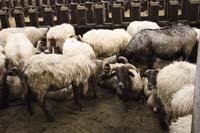
A noticeable improvement is observed in the profile or composition of the fat of seasonal cheeses that consume fresh grass, since the fatty acids that compose it are healthier. On the one hand, saturated fatty acids have decreased and unsaturated ones have increased. This has a direct positive influence on the indicator called atherogenic index that relates a food fat to its ability to damage the arteries. The value of this indicator has multiplied by 1.5 when herds consume fresh grass. This means that the fat in spring and summer cheeses has a weaker and healthier effect on the closure of the arteries.
Moreover, in milk there are certain conjugated fatty acids, called linoleic acids. When sheep graze in the fields, the amounts of conjugated linoleic acids naturally increase to double, according to the results of this study. We could say that, although cheese is a very fatty food, the fatty profile of cheeses that have been made in spring-summer with this production system is significantly better than that of winter cheeses.
Bookmarks Search
Since the consumption of grass by the sheep brings an added value to the final product, it would be interesting to develop a tool to ensure the use of this type of food. To this end, some compounds of herbaceous origin have been traceable. Once these compounds are ingested, sheep are expected to pass into the blood and into milk. Terpenes have been studied as marker compounds, some metabolites of plant origin.
As the milk production campaign progresses, it has been observed that the number of total terpenas has been growing and, in particular, the structurally more complex sesquiterpenes have been found only in summer milk. However, it has not been possible to propose a fixed marker compound for the consumption of grass, since the variability of the terpenic composition among spring milk has been very high and only in few milk samples have been detected sesquiterpenes.
There may be several reasons because the content of terpenes depends on many factors. For example, the different herbaceous species do not have the same type and number of terpenas, and with the degree of maturity of the plant their quantities change. In addition, in the process of animal digestion there can be a degradation of several compounds and, finally, when found in very small quantities, very sensitive methods are required for the detection of terpenes in milk. Further research should be carried out to delimit the scope of these compounds and ensure their usefulness.
Smell of cheese
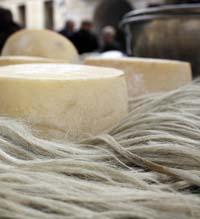
Finally, the aromatic profile of cheeses produced in the two epochs in which the type of food has been different has been analyzed. Volatile or volatile cheese compounds have been distributed and identified, including the strongest olfactory perceptions. Regardless of the production station, the most important contribution in the aroma of raw sheep milk cheese is that of five aromatic compounds in the family of acids, esters and ketones. These compounds are related to the spicy and penetrating smell typical of this type of cheese. Among the compounds that smell cheeses produced in the extensive spring system, those with a touch of fruit and sweet increase considerably. This indicates that the smell of spring cheeses can be softer than winter.
In summary, this study has shown that feeding herds with fresh fodder allows, from a technological point of view, the production of good quality milk and cheese, with a series of nutritional benefits. It allows sustainable use of available natural resources.
This article is based on a thesis work carried out at the UPV/EHU and carried out at the Faculty of Pharmacy by the research group Lactiker - Quality and Safety of Foods of Animal Origin Luis Javier R. Under the direction of Doctors Barron and Mailo Virto Lekuona.
Bibliography

Gai honi buruzko eduki gehiago
Elhuyarrek garatutako teknologia




